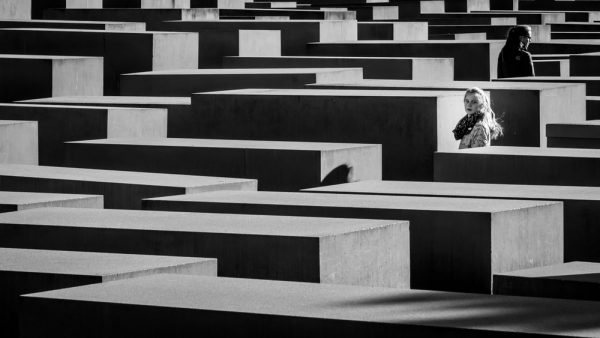“Hath not a Jew eyes?” How Critical Race Theory Sheds Light on Anti-Semitic Discourse
9 March 2020
As a person of hybrid Jewish heritage – my paternal grandma is an Ashkenazi Holocaust survivor; my paternal grandfather is Sephardic – I have felt both hesitancy and compulsion in equal measure to write about anti-Semitism, especially about anti-Semitism in the UK Left. (Yes, the Left in the UK has a real anti-Semitism problem, one that cannot be brushed under the carpet or ignored by self-righteously and indignantly claiming that ‘Oh, but the Tories are racist, too!’).
I have been hesitant, as I have found myself epistemically exploited by non-Jewish friends in conversation: despite their genuinely well-intentioned desires to learn about anti-Semitism and the like from Jewish folk (or at least ‘Jewish-enough’ folk like me (apparently), to use an expression I heard recently) – some of my non-Jewish friends fail to sufficiently grasp the unacknowledged labour and invariably recycled trauma of those who have experienced the symbolic and material harms of anti-Semitism either directly themselves or indirectly through their family history.
I have felt compulsion, as witnessing the UK Labour Party’s apparent institutionalised anti-Semitism has raised all sorts of important and necessary questions that must be addressed by left-wingers if Labour is to consistently and self-critically maintain its self-interpretation as the home of anti-racist struggles. As such, I want to draw attention to how the conceptual as well as phenomenological resources of critical race theory can shed further light on explaining the nature of anti-Semitic discourse as well as explicating why it is harmful and what is unique about it as a form of racial abuse. Contrary to some on the Left who remain either wilfully ignorant or non-wilfully ignorant, anti-Semitism is a real form of racism, and either the straightforward denial of anti-Semitism or wilful ignorance or non-wilful ignorance of anti-Semitism as a real form of racism reveals a disastrous critical theoretic irony: some on the Left are guilty of fetishizing and reifying the social category of oppression to exclude Jews from the class of oppressed and marginalised groups, because Jews don’t have the ‘look’, don’t have the ‘sound’, don’t have the ‘behaviour’ of the oppressed.
Racism usually attaches significance to bodily characteristics – someone’s skin colour, hair type, facial features, etc. Racist ideologies typically involve the marked and unmarked construction of hierarchies of ideal types against which others appear radically and problematically different, inferior, deviant, abject, base, and even disgusting. Arguably, the most important concept in the critical race theorist’s conceptual toolkit for making sense of racial oppression is W. E. B. Du Bois’s notion of ‘double consciousness’, which has its origins in his 1897 Atlantic Monthly article titled ‘Strivings of the Negro People’:
After the Egyptian and Indian, the Greek and Roman, the Teuton and Mongolian, the Negro is a sort of seventh son, born with a veil, and gifted with second-sight in this American world,—a world which yields him no true self-consciousness, but only lets him see himself through the revelation of the other world. It is a peculiar sensation, this double-consciousness, this sense of always looking at one’s self through the eyes of others, of measuring one’s soul by the tape of a world that looks on in amused contempt and pity. One ever feels his two-ness,—an American, a Negro; two souls, two thoughts, two unreconciled strivings; two warring ideals in one dark body, whose dogged strength alone keeps it from being torn asunder. The history of the American Negro is the history of this strife,—this longing to attain self-conscious manhood, to merge his double self into a better and truer self. In this merging he wishes neither of the older selves to be lost. (The Souls of Black Folk: 38)
For Du Bois, as part of their identification with fellow African-Americans in an African-American community, African-Americans communicatively self-interpret and find such communicative action empowering. However, African-Americans (and, of course, other people of colour), as part of a wider and racist world, are met with external and hostile web of meanings that radically distort such ethically and psychologically uplifting local self-conceptions.
The power structure of racial oppression is also especially pervasive in colonial environments, to the extent that the basic experiential relation people of colour have to themselves becomes distorted by how their view of their agency and their body from the perspective of traditional white prejudicial attitudes. To quote Frantz Fanon: “I cast an objective gaze over myself, discovered my blackness, my ethnic features; deafened by cannibalism, backwardness, fetishism, racial stigmas, slave traders, and above all, yes, above all, the grinning Y a bon Banania” (Black Skin, White Masks: 92). Under racist ideologies, not only is the web of meanings of black and other such cultures defined from a white perspective, but people of colour invariably start to regard their own agency and bodies from a 3rd-person racial point of view, namely ‘the white gaze’:
The white man is all around me; up above the sky is tearing at its navel; the earth crunches under my feet and sings white, white. All this whiteness burns me to a cinder … The white world, the only decent one, was preventing me from participating. It demanded that a man behave like a man. It demanded of me that I behave like a black man – or at least like a Negro. I hailed the world, and the world amputated my enthusiasm. I was expected to stay in line and make myself scarce. (Black Skin, White Masks: 94)
How can critical race theory contribute to making sense of the harms of anti-Semitic discourse, though? To begin sketching an answer, I would like to draw attention to an iconic passage from Shakespeare’s The Merchant of Venice, in which Shylock evocatively points out the long-standing and most enduring anti-Semitic tropes:
Signor Antonio, many a time and oft in the Rialto you have rated me about my moneys and my usances: Still have I borne it with a patient shrug, For sufferance is the badge of all our tribe. You call me misbeliever, cut-throat dog, and spit upon my Jewish gaberdine, and all for use of that which is mine own. Well then, it now appears you need my help: Go to, then; you come to me, and you say ‘Shylock, we would have moneys:’ you say so; You, that did void your rheum upon my beard and foot me as you spurn a stranger cur over your threshold: moneys is your suit. What should I say to you? Should I not say ‘Hath a dog money? Is it possible a cur can lend three thousand ducats?’ Or shall I bend low and in a bondman’s key, with bated breath and whispering humbleness, say this; ‘Fair sir, you spit on me on Wednesday last; You spurn’d me such a day; another time You call’d me dog; and for these courtesies I’ll lend you thus much moneys’?” (Act 1, Scene 3 – emphasis added)
Shylock’s powerful monologue here reveals ideological recognition in addition to the obvious dehumanising and crass anti-Semitic language and vocabulary. Ideological recognition concerns the ways in which an oppressive society grants positive respect and esteem to precisely those characteristics and achievements that serve to reinforce the very structures of individuals’ oppression. E.g.
- ‘Uncle Tom’ is accorded ‘high’ esteem to people of colour for adopting subservient and menial modes of behaviour
- ‘The good wife’ is accorded ‘high’ esteem for conforming to the patriarchal division of labour
- ‘The heroic soldier’ is accorded ‘high’ esteem, even as the material conditions for realising that honour entail likely destruction of their subjectivity and even their own ignoble death
- Jews are accorded ‘high’ esteem for their apparent shrewdness, cleverness, resourcefulness, and savviness
Positive public recognition may be beneficial to a person, but it may be symbolically and materially harmful to that person, if and when that recognition serves to reinforce social structures that oppress them. In this case, what one might legitimately call ‘Semitic Double-Consciousness’, as part of their identification with fellow Jews in a plurality of Jewish communities, Jews communicatively self-interpret. However, Jews, as part of a wider world, are met with web of meanings that either (i) ideologically recognise them by praising them for savviness and resourcefulness; or (ii) depersonalise and non-recognise them by defining them purely as economic phenomena and agents of capitalist exploitation and control. To paraphrase Fanon, in such scenarios, Jews cast an objective gaze over themselves, discover their Jewishness, their Jewish features, deafened by instrumentalization, cultural stigmas, and above all, yes, above all, the grinning money-lender.
But how can Jews, in this instance, start to overcome anti-Semitic discourse? I think one helpful answer is provided by this especially arresting and moving monologue by Shylock:
I am a Jew. Hath not a Jew eyes? Hath not a Jew hands, organs, dimensions, senses, affections, passions? Fed with the same food, hurt with the same weapons, subject to the same diseases, healed by the same means, warmed and cooled by the same winter and summer, as a Christian is? If you prick us, do we not bleed? If you tickle us, do we not laugh? If you poison us, do we not die? And if you wrong us, shall we not revenge? If we are like you in the rest, we will resemble you in that” (Act 3, Scene 1)
Rather than fetishize and reify the category of oppression to exclude Jews from the class of oppressed and marginalised groups, because they don’t look, don’t sound, don’t act oppressed like Syrian refugees, for instance, everyone on the UK Left would do well to reflect on Emmanuel Levinas’s concept of the rapport de face à face: for Levinas, the encounter with the Other’s eyes – in this case, the Jew’s eyes – “affects me before I begin to reflect on it. As indicated, it is dual: a command and a summons. Naked and defenceless, the face signifies, with or without words, “Do not kill me”. It opposes a passive resistance to our desire for mastery wherein our freedom asserts its sovereignty” (Totality and Infinity: 84).
In this way, Jeremy Corbyn’s rather pathetic non-apology for liking Mear One’s appalling anti-Semitic mural, saying that “[he] sincerely regret[s] that [he] did not look more closely at the image [he] was commenting on” reveals the deep extent of the structural pathology in Labour’s way of looking at Jews. Firstly, Corbyn & Co., as part of their self-avowed anti-racism and their insistence on a ‘kinder, gentler politics’, should, when looking at such images, remember Hannah Arendt’s famous claim that the Holocaust was a crime against humanity because Jews are people. Secondly, Corbyn & Co., as part of their self-avowed anti-racism, ironically define the web of meanings of Jewish cultures from a non-Jewish perspective. ‘Kinder, gentler politics’? For the many – not the Jew.
Picture: Yoav Aziz Memorial to the Murdered Jews of Europe, Berlin, Germany on unsplash
Comments
1 comment
Comments are closed.
- October 2025
- September 2025
- August 2025
- July 2025
- June 2025
- May 2025
- April 2025
- March 2025
- February 2025
- January 2025
- December 2024
- November 2024
- October 2024
- September 2024
- August 2024
- July 2024
- June 2024
- May 2024
- April 2024
- March 2024
- February 2024
- January 2024
- December 2023
- November 2023
- October 2023
- September 2023
- August 2023
- July 2023
- June 2023
- May 2023
- April 2023
- March 2023
- February 2023
- January 2023
- December 2022
- November 2022
- October 2022
- September 2022
- August 2022
- July 2022
- June 2022
- May 2022
- April 2022
- March 2022
- February 2022
- January 2022
- December 2021
- November 2021
- October 2021
- September 2021
- August 2021
- July 2021
- June 2021
- May 2021
- April 2021
- March 2021
- February 2021
- January 2021
- December 2020
- November 2020
- October 2020
- September 2020
- August 2020
- July 2020
- June 2020
- May 2020
- April 2020
- March 2020
- February 2020
- January 2020
- December 2019
- November 2019
- October 2019
- September 2019
- August 2019
- July 2019
- June 2019
- May 2019
- April 2019
- March 2019
- February 2019
- January 2019
- December 2018
- November 2018
- October 2018
- September 2018
- August 2018
- July 2018
- June 2018
- May 2018
- April 2018
- March 2018
- February 2018
- January 2018
- December 2017
- November 2017
- October 2017
- September 2017
- August 2017
- July 2017
- June 2017
- May 2017


no one has commented – so i will. yes, exactly, well done for writing this